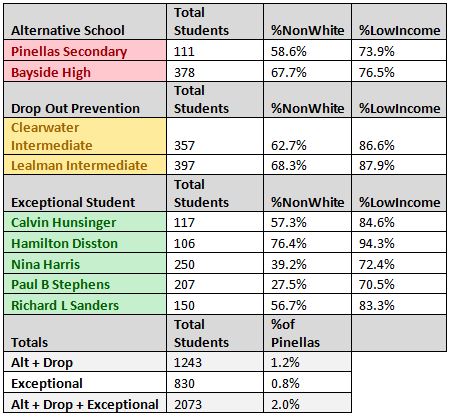 Charter schools are often accused of cherry picking students by expelling the lowest performers – a misleading claim I wrote about last week. But another recent example, this time in our backyard, offers a prompt to underscore another point: public school districts either transfer or assign troubled, low-performing, and special needs students out of district schools, and into specialty schools, all the time.
Charter schools are often accused of cherry picking students by expelling the lowest performers – a misleading claim I wrote about last week. But another recent example, this time in our backyard, offers a prompt to underscore another point: public school districts either transfer or assign troubled, low-performing, and special needs students out of district schools, and into specialty schools, all the time.
In this latest case, the Pinellas County School District began fielding complaints just a few weeks into the school year that a new charter school was kicking out kids with behavioral issues. As it turned out, the district was unable to find evidence this was happening. But what’s still noteworthy is how often districts take similar actions
Last year, the Pinellas district placed 1.2 percent of its low-performing and chronically disruptive students in special schools. When including schools for “exceptional students” (which includes special needs as well as mentally disturbed students) the enrollment is 2 percent of the district’s entire student population. The vast majority of these kids are nonwhite and low-income, as this chart shows:
For many possible reasons, traditional schools were not a good fit for these students, so the district either assigned them to another school in the beginning or transferred them later. Of course, no one is criticizing school districts for moving these students. And I don’t think they should.
In fact, we should celebrate the fact that districts are using specialty schools to meet the unique needs of these disadvantaged and troubled students.
We should remember this before jumping to conclusions about charter schools too. Charters don’t have a network of specialty schools to fall back on like public schools. So when a student is chronically disruptive or violent, or when the school simply doesn’t have the means to serve that student’s needs, it may not have any other choice but to expel the student or recommend a transfer.
Barring a much more detailed analysis, using transfer, suspension and expulsion rates to criticize charter schools simply isn’t fair. That’s especially true if you jump to conclusions and assume charter operators have the worst motivations.




When charters are run by for profit management companies they have a financial incentive to council out academically poor performers, discipline problems and special needs kids. Furthermore they have no incentive to try and help those kids because often that costs money.
A charter school in effect is a micro school district and if they are going to take on that responsibility the should take on all the responsibilities that entails.
Also where do you think the kids they won’t take go? Back to public schools that’s where.
Finally sure there are great charter schools that really care about their kids but there are also way to many charter schools that are in it to make a buck or don’t know what they are doing.
It’s a wonder how the poor ever get fed or housed with all those for-profit grocery stores and apartments/home builders…
It’s an interesting theory but it falls flat. Especially when there are many private and charter schools catering to special needs, low-income and troubled children…despite critics trying to limit the available funds at every possible turn…
Patrick—I appreciate you sharing this research. What’s not included in your data is what’s called “administrative transfers.” School districts will at times force students to leave a school and enroll in another school. Usually this is done for crowding or safety concerns.
A few years ago, the Pinellas School District forced about thirty students to leave Johns Hopkins Middle School because of several fights at the school. These students were all administratively transferred to other district schools. The school district did the same thing at Gibbs High School around this same time.
At Step Up For Students, we regularly hear from parents that their child’s school district guidance counselor recommended they apply for a tax credit scholarship in order to afford tuition at a particular private school. These guidance counselors are almost always well intentioned. They are putting the students’ needs first and recommending a school they think will better serve that child.
As charter, virtual and private schools become more assimilated into the new definition of public education, all this charter versus district school discussion will dissipate and we’ll get back to focusing exclusively on what’s best for kids.
Patrick—I appreciate you sharing this research. What’s not included in your data is what’s called “administrative transfers.” School districts will at times force students to leave a school and enroll in another school. Usually this is done for crowding or safety concerns.
A few years ago, the Pinellas School District forced about thirty students to leave Johns Hopkins Middle School because of several fights at the school. These students were all administratively transferred to other district schools. The school district did the same thing at Gibbs High School around this same time.
At Step Up For Students, we regularly hear from parents that their child’s school district guidance counselor recommended they apply for a tax credit scholarship in order to afford tuition at a particular private school. These guidance counselors are almost always well intentioned. They are putting the students’ needs first and recommending a school they think will better serve that child.
As charter, virtual and private schools become more assimilated into the new definition of public education, all this charter versus district school discussion will dissipate and we’ll all get back to focusing on what’s best for kids.
Great points there. You are right, charter schools are part of the school system.
For profit grocery stores? I guess you think picking a school should be like buying milk. Grocery stores have an incentive for people to return, charter schools have an incentive to produce high numbers, something they often can’t always do with discipline problems, ese, esol, poor performers.
When you give the entire charter school industry cover you do those few good ones a disservice. reading your posts it seems like you want your answer to be right and are not concerned with having the right answer.